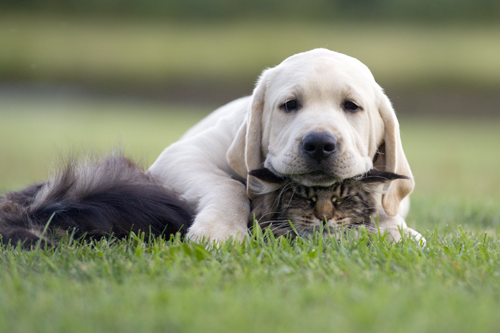 I will get to the lovesick goat, but not yet.
I will get to the lovesick goat, but not yet.
First, let’s talk about cat videos.
A few years ago, I attended a conference on using technology for good. At a session about promoting citizenship through the use of the Internet, someone asked the speaker about YouTube. The man said, despondently, that half of YouTube was videos of cats flushing the toilet. America might just be doomed by feline flushing.
For what it’s worth, a search for “cat” on YouTube yields 29.6 million results, while “Cat flushing a toilet” comes up with a measly 35,000. However, there is a super-cute music video of many cats flushing many toilets that has 678,988 views.
For what it’s worth, a search for “cat” on YouTube yields 29.6 million results, while “Cat flushing a toilet” comes up with a measly 35,000. However, there is a super-cute music video of many cats flushing many toilets that has 678,988 views.
By the way, I think any cat willing to use a toilet while being filmed should be allowed to vote.
When are we going to stop trying to prove that our pets are “just like us”? Or that they like us? Or figure out why we like them? Recently, Paul J. Zak, Ph.D., a researcher and “neuroeconomist” who has been dubbed “Dr. Love,” wanted to find out the scientific reason why he wept while he held his dog Teddy’s paw as the dog was put to sleep.
I know you know the answer to this, but keep in mind: (a) Dr. Zak is a cat person, and (b) Dr. Zak is a neuroeconomist.
Dr. Zak has made a career of tracking oxytocin, a mammalian hormone that plays a significant role in fostering maternal bonding, intimacy, and trust in lots of mammals, from humans to prairie voles. He thought his tears might have been oxytocin-based, that his relationship with Teddy had given him the chemical equivalent of a love affair with a human.
So he had his human subjects pet cats. He had people pet dogs. And he drew blood samples from the humans before and after.
The results were disappointing. Oxytocin rose, but not the way it did when people were lovesick or when a mother sees her newborn. And the oxytocin boost appeared in only 30% of the subjects. These animals didn’t give humans that buzz.
Random helpful facts: Dogs are better at reducing your stress and make you more likely to lend money.
Oxytocin-wise, things work a little differently with a dog and that goat.
The BBC, which is based in the country where the Queen’s corgi has appeared on a coin, hired Dr. Zak to see if this oxytocin boost thing worked between two different species of animals.
So Dr. Zak traveled to an animal shelter in Arkansas where many different kinds of animals interact. His subjects were a mixed-breed terrier and a goat that were regular playmates. Same deal: blood sample before and after.
The goat wrestled with the dog. The dog wrestled with the goat. Good times. After 15 minutes, the researchers took a second blood sample. And the results told a tragic love story as old as time. The dog’s oxytocin was highly elevated. To Mr. Dog, Mr. Goat was a good buddy. But the goat’s blood levels were astronomical. To quote Dr. Zak: “The only time I have seen such a surge in oxytocin in humans is when someone sees a loved one, is romantically attracted to someone, or is shown an enormous kindness.”
Translation: If Mr. Goat had been a person, he’d be drawing “I HEART MR. DOG” all over his notebooks. And wondering why Mr. Dog doesn’t call him more often.
Still, these dogs started out as pals. They got an easy “A.”
My dog, Faith, saw most animals as enemies or food sources. Once, she confidently flung herself into a lake to pursue a flock of angry geese hundreds of feet away. “She has a high prey drive,” our dog trainer once said, as a compliment. “She would make a great drug dog.” I wish I’d gotten her that drug-dog job. My husband and I would have jumped into fewer lakes.
Through the slats of the fence, one tiny lamb blinked. [My dog] Faith didn’t lunge—she walked quietly up to the fence, turned around and lay down, right in front of the little lamb, and would not move. She guarded that lamb as if she’d been a farm dog all her life, not a battle-scarred pit bull mix from Jersey City.
Then Faith turned around and lay down, right in front of the little lamb, and would not move. She guarded that lamb as if she’d been a farm dog all her life, not a battle-scarred pit bull mix from Jersey City.
The dog trainer had it wrong. Faith had found finally found her job: Guarder of Tiny Sheep.
It took all my strength to drag her out of the park while Faith sighed, whined, and looked back at the lamb. Honestly, I didn’t want to leave either. I was in the presence of a miracle.
Why that lamb? Why that day? Was it one-sided? Without a blood sample, I will never know. But I think about that day a lot. My lion had lain down with her lamb. It was the kind of transformation people long for but almost never pull off.
Are animals just like us? I’m beginning to think the question is: Why can’t we be more like them?
Related Reading
- Interaction with Animals Provides Valuable Therapy for Humans
- Science Supports What Many People Already Knew: Dogs Love Us
Post Disclaimer
This content is for informational purposes only and does not constitute medical advice. Please consult a healthcare professional for any medical concerns.




5 Comments
John Larson
beautiful story. it’s unfortunate humans weren’t more like other animals. we would live in a much more civilized and peaceful world.
Katie Leahy
This is an interesting concept for me and I will tell you why. Every single animal that lives in my home has been abused by humans, and yet they still love humans and one another. I am convinced that animals do not possess the ability to hate or to hold a grudge. Their propensity to love and to be kind far outweighs their ability to hate.
My dog Indigo was tortured by a human for 2 years. He was chained up outside from the age of 6 weeks old until animal control took him away. The day animal control was called it was because his owner was beating him with a shovel. That shovel caused a spinal chord injury leaving Indy dependent on diapers, a wheel chair and leg braces. When Indy came to my home as a foster dog, I was skeptical about him and how he would be with people. I needent have worried, he came home and immediately fell in love with every human and animal in the home. He is still this way, every person he meets is a new best friend and every dog, cat, sheep, goat, pig, spider and toad he encounters is also a best friend. He completely lacks the propensity to hate because his propensity to love is so massive. He teaches me every day to be kinder and more loving. All 8 of my dogs and all 5 of my cats do the same. I don’t know and I don’t care if there is a chemical or hormonal reason for why animals at the way they are, because it really doesent matter when you get down to the nuts and bolts of it, because all we need to do is tune in and learn from them.
Jason Black
Lovely story! Thank you for sharing it with us.
Diane
Love this story. Dogs have the added plus for humans of being facilitators of interactions of the humans walking them. A little boy dog’s love for my Bichonesque rescue Katy has led us to regularly visit the 99-year-old neighbor whose caregiver brings her dog to work. My cat .. not so much.
Kate Maloy
I love this story, Martha–that poor goat, so smitten, and poor Faith having to leave her baby lamb. I remember when you got Faith, and how hard you worked to overcome her fears and aggression. Great job, with her and this essay. Very moving.